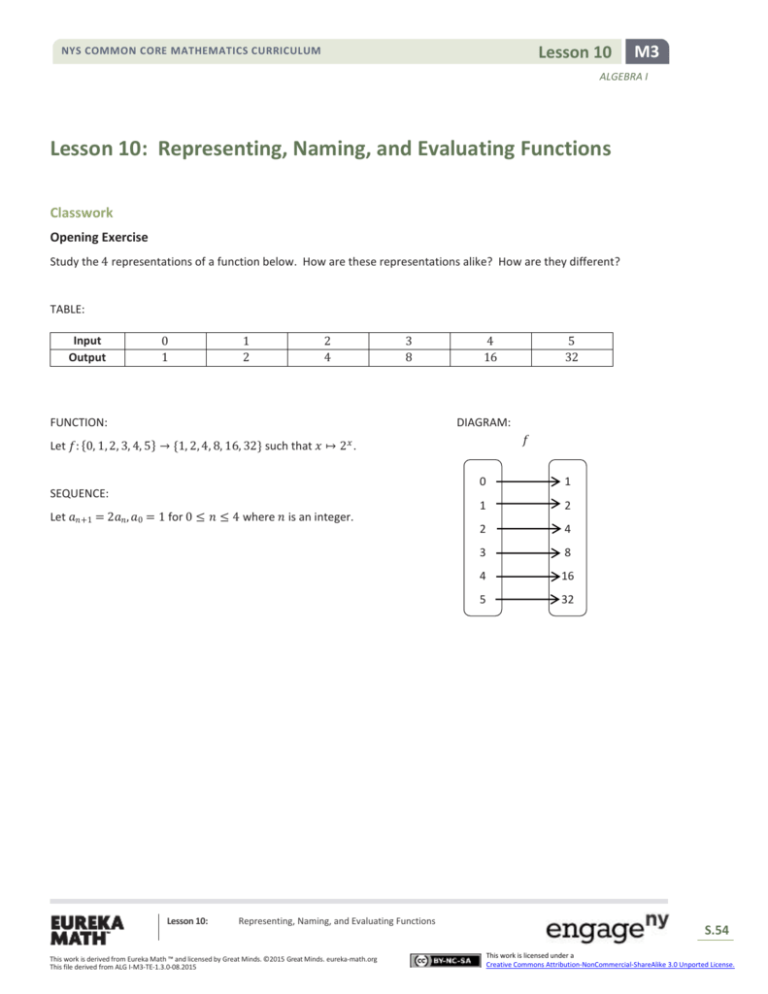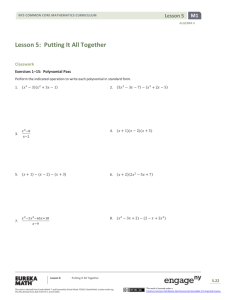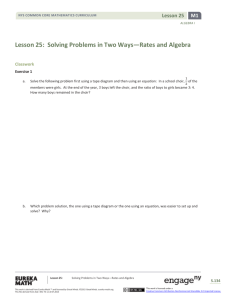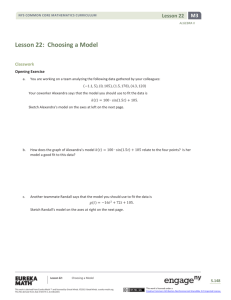Algebra I Module 3, Topic B, Lesson 10: Student Version
advertisement

Lesson 10
NYS COMMON CORE MATHEMATICS CURRICULUM
M3
ALGEBRA I
Lesson 10: Representing, Naming, and Evaluating Functions
Classwork
Opening Exercise
Study the 4 representations of a function below. How are these representations alike? How are they different?
TABLE:
Input
Output
0
1
1
2
2
4
3
8
FUNCTION:
4
16
5
32
DIAGRAM:
𝑓
𝑥
Let 𝑓: {0, 1, 2, 3, 4, 5} → {1, 2, 4, 8, 16, 32} such that 𝑥 ↦ 2 .
SEQUENCE:
Let 𝑎𝑛+1 = 2𝑎𝑛 , 𝑎0 = 1 for 0 ≤ 𝑛 ≤ 4 where 𝑛 is an integer.
Lesson 10:
Representing, Naming, and Evaluating Functions
This work is derived from Eureka Math ™ and licensed by Great Minds. ©2015 Great Minds. eureka-math.org
This file derived from ALG I-M3-TE-1.3.0-08.2015
0
1
1
2
2
4
3
8
4
16
5
32
S.54
This work is licensed under a
Creative Commons Attribution-NonCommercial-ShareAlike 3.0 Unported License.
M3
Lesson 10
NYS COMMON CORE MATHEMATICS CURRICULUM
ALGEBRA I
Exercise 1
Let 𝑋 = {0, 1, 2, 3, 4, 5}. Complete the following table using the definition of 𝑓.
𝑓: 𝑋 → 𝑌
Assign each 𝑥 in 𝑋 to the expression 2𝑥 .
𝒙
0
1
2
3
4
5
𝒇(𝒙)
What are 𝑓(0), 𝑓(1), 𝑓(2), 𝑓(3), 𝑓(4), and 𝑓(5)?
What is the range of 𝑓?
Exercise 2
The squaring function is defined as follows:
Let 𝑓: 𝑋 → 𝑌 be the function such that 𝑥 ↦ 𝑥 2 , where 𝑋 is the set of all real numbers.
2
3
What are 𝑓(0), 𝑓(3), 𝑓(−2), 𝑓(√3), 𝑓(−2.5), 𝑓 ( ), 𝑓(𝑎), and 𝑓(3 + 𝑎)?
What is the range of 𝑓?
Lesson 10:
Representing, Naming, and Evaluating Functions
This work is derived from Eureka Math ™ and licensed by Great Minds. ©2015 Great Minds. eureka-math.org
This file derived from ALG I-M3-TE-1.3.0-08.2015
S.55
This work is licensed under a
Creative Commons Attribution-NonCommercial-ShareAlike 3.0 Unported License.
Lesson 10
NYS COMMON CORE MATHEMATICS CURRICULUM
M3
ALGEBRA I
What subset of the real numbers could be used as the domain of the squaring function to create a range with the same
output values as the sequence of square numbers {1, 4, 9, 16, 25, … } from Lesson 9?
Exercise 3
Recall that an equation can either be true or false. Using the function defined by 𝑓: {0, 1, 2, 3, 4, 5} → {1, 2, 4, 8, 16, 32}
such that 𝑥 ↦ 2𝑥 , determine whether the equation 𝑓(𝑥) = 2𝑥 is true or false for each 𝑥 in the domain of 𝑓.
𝒙
Is the equation
𝒇(𝒙) = 𝟐𝒙
true or false?
Justification
True
Substitute 0 into the equation.
𝑓(0) = 20
1 = 20
The 1 on the left side comes from the definition of 𝑓, and the
value of 20 is also 1, so the equation is true.
0
1
2
3
4
5
Lesson 10:
Representing, Naming, and Evaluating Functions
This work is derived from Eureka Math ™ and licensed by Great Minds. ©2015 Great Minds. eureka-math.org
This file derived from ALG I-M3-TE-1.3.0-08.2015
S.56
This work is licensed under a
Creative Commons Attribution-NonCommercial-ShareAlike 3.0 Unported License.
NYS COMMON CORE MATHEMATICS CURRICULUM
Lesson 10
M3
ALGEBRA I
If the domain of 𝑓 were extended to all real numbers, would the equation still be true for each 𝑥 in the domain of 𝑓?
Explain your thinking.
Exercise 4
Write three different polynomial functions such that 𝑓(3) = 2.
Exercise 5
The domain and range of this function are not specified. Evaluate the function for several values of 𝑥. What subset of
the real numbers would represent the domain of this function? What subset of the real numbers would represent its
range?
Let 𝑓(𝑥) = √𝑥 − 2
Lesson 10:
Representing, Naming, and Evaluating Functions
This work is derived from Eureka Math ™ and licensed by Great Minds. ©2015 Great Minds. eureka-math.org
This file derived from ALG I-M3-TE-1.3.0-08.2015
S.57
This work is licensed under a
Creative Commons Attribution-NonCommercial-ShareAlike 3.0 Unported License.
Lesson 10
NYS COMMON CORE MATHEMATICS CURRICULUM
M3
ALGEBRA I
Lesson Summary
ALGEBRAIC FUNCTION: Given an algebraic expression in one variable, an algebraic function is a function 𝑓: 𝐷 → 𝑌 such
that for each real number 𝑥 in the domain 𝐷, 𝑓(𝑥) is the value found by substituting the number 𝑥 into all instances
of the variable symbol in the algebraic expression and evaluating.
The following notation will be used to define functions going forward. If a domain is not specified, it is assumed to
be the set of all real numbers.
For the squaring function, we say
Let 𝑓(𝑥) = 𝑥 2 .
For the exponential function with base 2, we say
Let 𝑓(𝑥) = 2𝑥 .
When the domain is limited by the expression or the situation to be a subset of the real numbers, it must be
specified when the function is defined.
For the square root function, we say
Let 𝑓(𝑥) = √𝑥 for 𝑥 ≥ 0.
To define the first 5 triangular numbers, we say
Let 𝑓(𝑥) =
𝑥(𝑥+1)
for 1 ≤ 𝑥 ≤ 5 where 𝑥 is an integer.
2
Depending on the context, one either views the statement “𝑓(𝑥) = √𝑥 ” as part of defining the function 𝑓 or as an
equation that is true for all 𝑥 in the domain of 𝑓 or as a formula.
Problem Set
1.
Let 𝑓(𝑥) = 6𝑥 − 3, and let 𝑔(𝑥) = 0.5(4) 𝑥 . Find the value of each function for the given input.
a.
𝑓(0)
j.
𝑔(0)
b.
𝑓(−10)
k.
𝑔(−1)
c.
𝑓(2)
l.
𝑔(2)
d.
𝑓(0.01)
m. 𝑔(−3)
e.
𝑓(11.25)
n.
𝑔(4)
f.
𝑓(−√2)
o.
𝑔(√2)
g.
𝑓( )
5
3
p.
𝑔( )
h.
𝑓(1) + 𝑓(2)
q.
𝑔(2) + 𝑔(1)
i.
𝑓(6) − 𝑓(2)
r.
𝑔(6) − 𝑔(2)
Lesson 10:
1
2
Representing, Naming, and Evaluating Functions
This work is derived from Eureka Math ™ and licensed by Great Minds. ©2015 Great Minds. eureka-math.org
This file derived from ALG I-M3-TE-1.3.0-08.2015
S.58
This work is licensed under a
Creative Commons Attribution-NonCommercial-ShareAlike 3.0 Unported License.
Lesson 10
NYS COMMON CORE MATHEMATICS CURRICULUM
M3
ALGEBRA I
2.
3.
4.
5.
Since a variable is a placeholder, we can substitute letters that stand for numbers in for 𝑥. Let 𝑓(𝑥) = 6𝑥 − 3, and
let 𝑔(𝑥) = 0.5(4) 𝑥 , and suppose 𝑎, 𝑏, 𝑐, and ℎ are real numbers. Find the value of each function for the given
input.
a.
𝑓(𝑎)
h.
𝑔(𝑏)
b.
𝑓(2𝑎)
i.
𝑔(𝑏 + 3)
c.
𝑓(𝑏 + 𝑐)
j.
𝑔(3𝑏)
d.
𝑓(2 + ℎ)
k.
𝑔(𝑏 − 3)
e.
𝑓(𝑎 + ℎ)
l.
𝑔(𝑏 + 𝑐)
f.
𝑓(𝑎 + 1) − 𝑓(𝑎)
m. 𝑔(𝑏 + 1) − 𝑔(𝑏)
g.
𝑓(𝑎 + ℎ) − 𝑓(𝑎)
What is the range of each function given below?
a.
Let 𝑓(𝑥) = 9𝑥 − 1.
b.
Let 𝑔(𝑥) = 32𝑥 .
c.
Let 𝑓(𝑥) = 𝑥 2 − 4.
d.
Let ℎ(𝑥) = √𝑥 + 2.
e.
Let 𝑎(𝑥) = 𝑥 + 2 such that 𝑥 is a positive integer.
f.
Let 𝑔(𝑥) = 5𝑥 for 0 ≤ 𝑥 ≤ 4.
Provide a suitable domain and range to complete the definition of each function.
a.
Let 𝑓(𝑥) = 2𝑥 + 3.
b.
Let 𝑓(𝑥) = 2𝑥 .
c.
Let 𝐶(𝑥) = 9𝑥 + 130, where 𝐶(𝑥) is the number of calories in a sandwich containing 𝑥 grams of fat.
d.
Let 𝐵(𝑥) = 100(2) 𝑥 , where 𝐵(𝑥) is the number of bacteria at time 𝑥 hours over the course of one day.
Let 𝑓: 𝑋 → 𝑌, where 𝑋 and 𝑌 are the set of all real numbers, and 𝑥 and ℎ are real numbers.
a.
Find a function 𝑓 such that the equation 𝑓(𝑥 + ℎ) = 𝑓(𝑥) + 𝑓(ℎ) is not true for all values of 𝑥 and ℎ.
Justify your reasoning.
b.
Find a function 𝑓 such that equation 𝑓(𝑥 + ℎ) = 𝑓(𝑥) + 𝑓(ℎ) is true for all values of 𝑥 and ℎ.
Justify your reasoning.
c.
Let 𝑓(𝑥) = 2𝑥 . Find a value for 𝑥 and a value for ℎ that makes 𝑓(𝑥 + ℎ) = 𝑓(𝑥) + 𝑓(ℎ) a true number
sentence.
Lesson 10:
Representing, Naming, and Evaluating Functions
This work is derived from Eureka Math ™ and licensed by Great Minds. ©2015 Great Minds. eureka-math.org
This file derived from ALG I-M3-TE-1.3.0-08.2015
S.59
This work is licensed under a
Creative Commons Attribution-NonCommercial-ShareAlike 3.0 Unported License.
Lesson 10
NYS COMMON CORE MATHEMATICS CURRICULUM
M3
ALGEBRA I
6.
Given the function 𝑓 whose domain is the set of real numbers, let 𝑓(𝑥) = 1 if 𝑥 is a rational number, and let
𝑓(𝑥) = 0 if 𝑥 is an irrational number.
a.
Explain why 𝑓 is a function.
b.
What is the range of 𝑓?
c.
Evaluate 𝑓 for each domain value shown below.
2
3
𝒙
0
−5
√2
𝜋
𝒇(𝒙)
d.
List three possible solutions to the equation 𝑓(𝑥) = 0.
Lesson 10:
Representing, Naming, and Evaluating Functions
This work is derived from Eureka Math ™ and licensed by Great Minds. ©2015 Great Minds. eureka-math.org
This file derived from ALG I-M3-TE-1.3.0-08.2015
S.60
This work is licensed under a
Creative Commons Attribution-NonCommercial-ShareAlike 3.0 Unported License.











